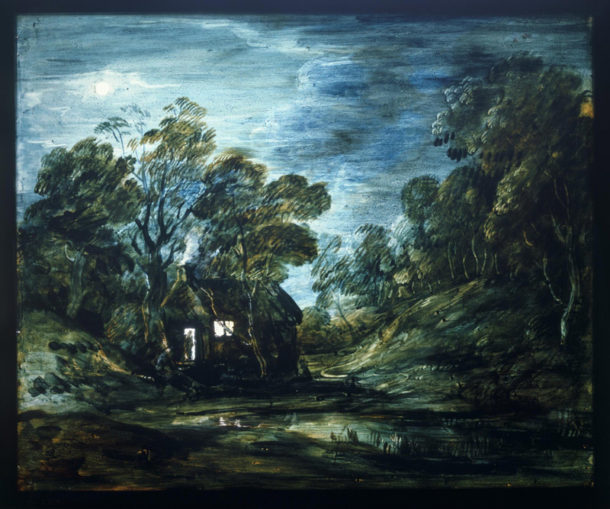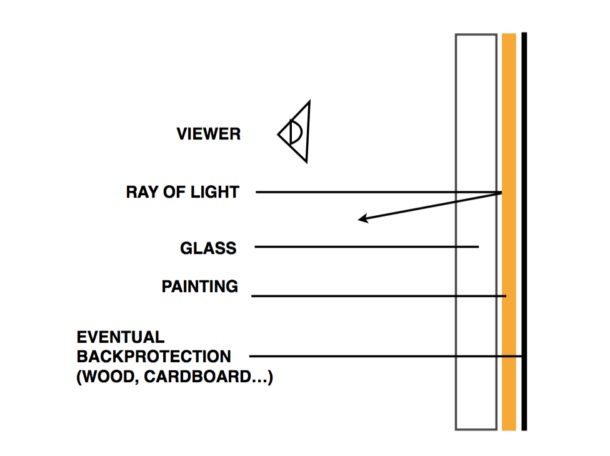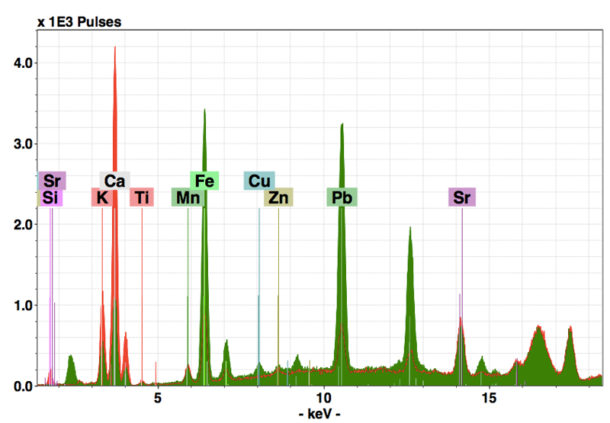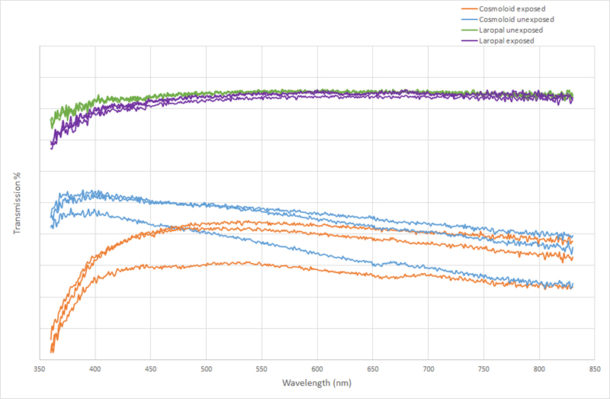by Marine Andrieux, Student Placement, Paintings Conservation
‘Wooded Moonlight Landscape with Pool and Figure at the Door of a Cottage’ (P.33-1955) was painted on a 31 x 37 cm sheet of glass by Thomas Gainsborough in 1781-2 (Figure 1). This oil transparency is part of a series of 10 reverse glass paintings created by the artist in his late career, between 1781 and 1786. They were made to be backlit and viewed from the unpainted side in a showbox he designed with illumination provided by five candles (P.44-1955). Gainsborough’s major inspiration for this work was the mechanical theatre named ‘Eidophusikon’ invented by Philippe de Loutherbourg, for which he had a great admiration.1 For two years De Loutherbourg gave representations of dramatic and illusionistic scenes painted on paper. Gainsborough was inspired to create his own private Eidophusikon. The showbox he designed can be described as a mixture between a camera obscura and a magic lantern; instead of an image projected through a lens, the viewer looks inside the box and sees the transparency backlit.

Traditionally, reverse glass painting consists of several layers of paint applied to one side of the glass while the painting is viewed from the other side. In creating such a painting, the sequence of paint application is reversed (Figure 2). The foreground and highlights are painted first and must be correct, then the layers are built up, with the background applied last. With these paintings, the glass can be said to have several functions: a painting substrate, a protective layer of plain glass and a coating which performs an aesthetic function by making the colours more saturated.2

The painting was examined under a microscope, using UV lamps and with x-ray fluorescence (XRF) in order to learn more about Gainsborough’s technique and the painting’s condition (Figure 3). It is not easy to distinguish the different layers. In contrast to normal practice, there is no ground between the support and the paint layers, although a mordant is usually applied to improve adhesion. A deeper study of Gainsborough’s technique revealed that he applied a red colour as an initial layer where he wanted a warm and opaque effect; this can be seen in the lower left of the painting. In some areas the paint is very thin and translucent while others are more opaque. As the painting was created to be seen in transmitted light in the showbox, Gainsborough used a sgraffito technique, scraping away the paint to create the brightest highlights and to depict the moon, cottage window and door. He also worked on the fresh painting to draw some shapes. XRF analysis of the glass sheet showed the presence of calcium (Ca), potassium (K) and silicon (Si). XRF analysis of the paint in the sky indicated the presence of iron (Fe) and lead (Pb). This is consistent with the possible presence of a mixture of Prussian blue and lead white and is consistent with Gainsborough’s known pigment use.3 The analyses provided a better understanding of Gainsborough’s late technique and useful information about the general technique of reverse glass painting in the eighteenth century.

The painting was not in a suitable condition for exhibition or transport as paint was lifting in the sky and many other areas. This lack of adhesion was visible through the glass as air gaps between paint and glass and had a grey appearance. The objective of the proposed treatment was to secure the paint to the glass substrate and enable the painting to be displayed. With that aim, research into various adhesives was conducted. The first criterion for an adhesive is to have good aging properties. In this particular intervention it was essential that the adhesive aged well and would not yellow with time as it would be between the painting and the glass, and consequently the viewer.
A selection of adhesives were chosen for testing including Lascaux Medium for Consolidation (4176), Paraloid B72, Regalrez 1094 and Laropal A81 in solvent solutions. Wax-resin mixtures were also tested, using the last three resins together with Cosmoloid H80 wax, as suggested in the specialist literature on the treatment of reverse glass paintings. Samples of these adhesives were aged in a daylight box for 720 hours and then analysed by a spectrophotometer. The results showed that the most stable adhesive was Laropal A81, a synthetic aldehyde resin (Figure 4). As the wax-resin mixtures yellowed more in the ageing tests, they were rejected.

Application methods were tested on artificially aged paint samples. For the wax-resin mixtures, these included a hot needle and spatula, and for the adhesives in solutions, brush, weight, spray and Leister (pressure and hot air diffuser). The spray application of the adhesive was the most effective method as it allowed a deeper penetration of the adhesive in the air gaps between the glass and the paint.
Following experimentation with three different concentrations, a 10% solution of Laropal A81 in Shellsol A100 was selected and sprayed on to the areas with lifting paint. After the solvent had evaporated, the paint was reattached to the glass using a heated spatula (60 to 80˚C) while working under a microscope. The heat helped to spread the adhesive and at the same time pressure helped to reattach the raised paint. The process was repeated in order to improve the adhesion. The air bubbles between the paint layer and the glass are now minimal. Retouching was carried out with Gamblin Conservation Colors (pigments bound in same resin) on the lower left corner to three small losses and two in the blue area. After years of being stored flat to avoid paint loss, Gainsborough’s ’Wooded Moonlight Landscape’ can once again be displayed.
Acknowledgments
I am grateful to Nicola Costaras, Head Paintings Conservator, Mark Evans, Senior Curator of Paintings, Boris Pretzel, Head of Science Section and Bhavesh Shah, Scientist (Environment) for their guidance throughout this project.
References
- Slowman, S., Barell, J., Rosenthal M. Bermingham, A. et al. Sensation and Sensibility. Viewing Gainsborough’s cottage door, ed. A. Bermingham, 2005. p.23
- Pattyn, H. ‘A propos de la peinture sous verre: question de vocabulaire’ in Les arts du verre, Journées d’études de la SFIIC, Paris 1991, pp. 97 – 102.
- Bucklow, S. and Mandy, K. ‘The Gainsborough’s House paint bladders : tin-based mordants and the attribution of artists’ materials’ in The Hamilton Kerr Institute Bulletin, No. 6, Archetype Publications Ltd in association with the University of Cambridge, 2016, pp.21-28.
‘Wooded Moonlight Landscape with Pool and Figure at the Door of a Cottage’ was bequeathed by Ernest E. Cook through The Art Fund.


